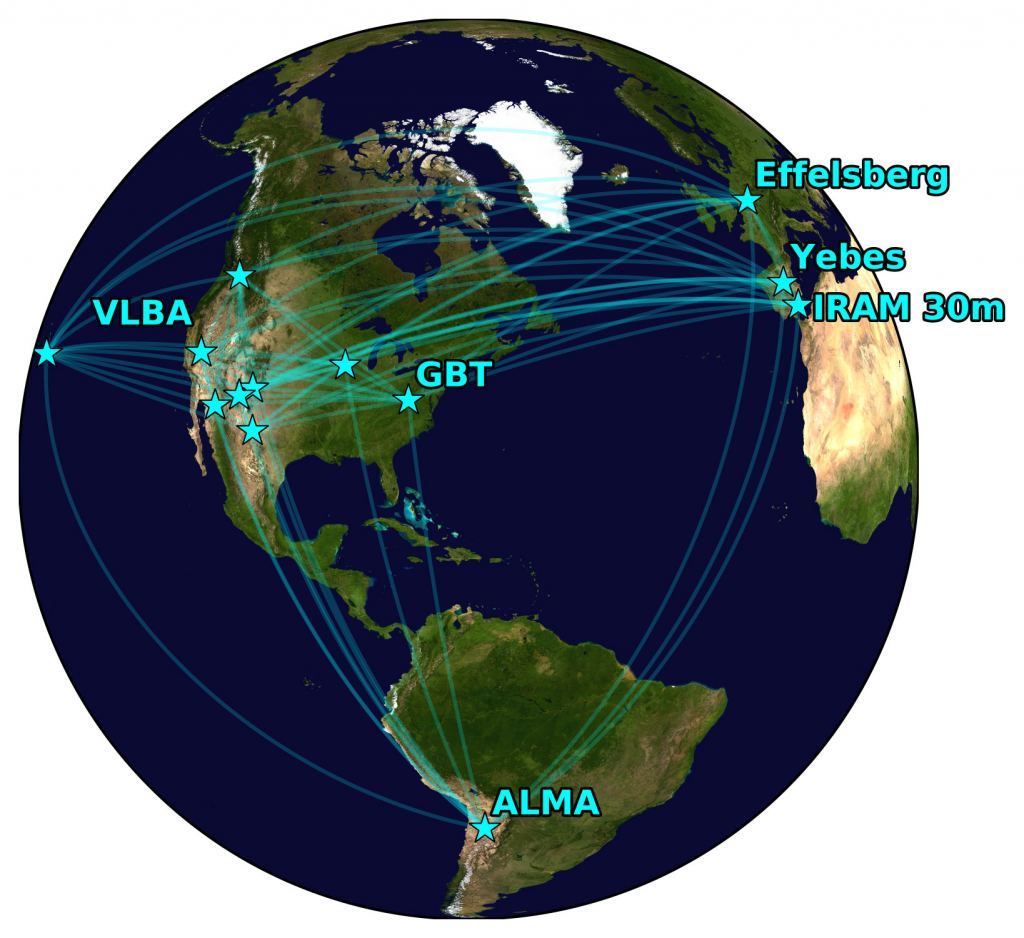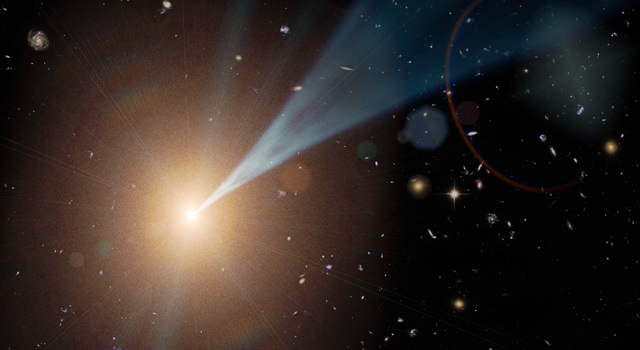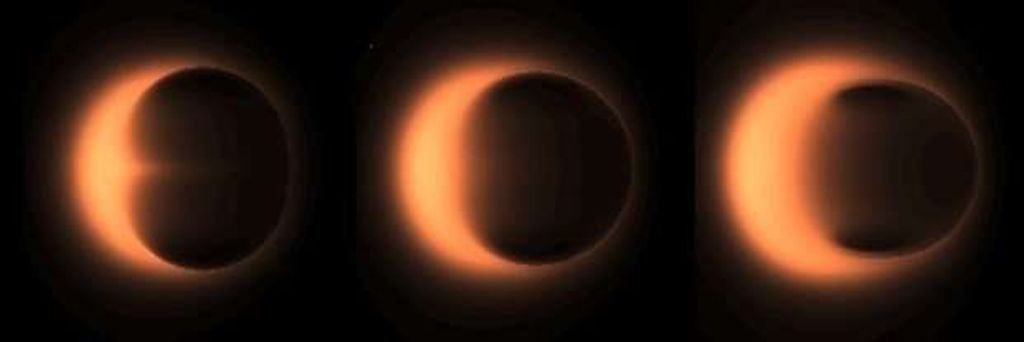An almost unimaginably enormous black hole is situated at the heart of the Milky Way. It’s called a Supermassive Black Hole (SMBH), and astronomers think that almost all massive galaxies have one at their center. But of course, nobody’s ever seen one (sort of, more on that later): It’s all based on evidence other than direct observation.
The Milky Way’s SMBH is called Sagittarius A* (Sgr. A*) and it’s about 4 million times more massive than the Sun. Scientists know it’s there because we can observe the effect it has on matter that gets too close to it. Now, we have one of our best views yet of Sgr. A*, thanks to a team of scientists using a technique called interferometry.
As Sgr. A*’s powerful gravity draws gas and dust towards it, the gas and dust swirls around the hole. An enormous amount of energy is radiated somehow, which astronomers can see. But astronomers aren’t exactly certain what releases this energy. Is it coming from the swirling material? Or is it coming from jets of material shooting away from the hole?
“The source of the radiation from Sgr A* has been debated for decades.”
Michael Johnson of the Center for Astrophysics | Harvard and Smithsonian (CfA)
“The source of the radiation from Sgr A* has been debated for decades,” says Michael Johnson of the Center for Astrophysics | Harvard and Smithsonian (CfA). “Some models predict that the radiation comes from the disk of material being swallowed by the black hole, while others attribute it to a jet of material shooting away from the black hole. Without a sharper view of the black hole, we can’t exclude either possibility.”

So understanding black holes means astronomers need to see more clearly into the region of the hole. But events at Sgr. A* are obscured by lumpy clouds of electrons between us and center of the galaxy. And these clouds blur and distort our view of the black hole.
A team of astronomers have succeeded in looking through these electron clouds to see more clearly what’s going on at Sgr. A*. The team is led by
Radboud University PhD student Sara Issaoun, and to see into Sgr. A*’s neighborhood, they relied on a technique called Very Long Baseline Interferometry (VLBI).
The result? One of our clearest images yet of what goes on at our galaxy’s supermassive black hole.

The Global Millimeter VLBI Array, joined by ALMA. Credit: S. Issaoun, Radboud University/ D. Pesce, CfA
Interferometry is the technique of harnessing multiple telescopes together to image a distant object more effectively. The further apart the ‘scopes are, the longer the baseline is and the larger the effective aperture is. With VLBI, used in this research, the individual telescopes span the globe, creating an enormous sort of virtual telescope.
But there have been other interferometers, and they didn’t see Sgr. A* this clearly. The team behind this study made one other advance in interferometry. They equipped the powerful ALMA (Atacama Large Millimeter Array) in Chile with new electronics, called a phasing system. That allowed ALMA, which is already an interferometer, to join a network of 12 other telescope called GMVA (Global 3mm VLBI Array). As the name says, GMVA is already a Very Long Baseline Interferometer. So joining GMVA with ALMA creates a sort of Super VLBI.
“…we are looking at this beast from a very special vantage point.”
Heino Falcke, Professor of Radio Astronomy at Radboud University.
“ALMA itself is a collection of more than 50 radio dishes. The magic of the new ALMA Phasing System is to allow all these dishes to function as a single telescope, which has the sensitivity of a single dish more than 75 meters across. That sensitivity, and its location high in the Andes mountains, makes it perfect for this Sgr A* study,” says Shep Doeleman of the CfA, who was Principal Investigator of the ALMA Phasing Project.
“The breakthrough in image quality came from two factors,” explains Lindy Blackburn, a radio astronomer at the CfA. “By observing at high frequencies, the image corruption from interstellar material was less significant, and by adding ALMA, we doubled the resolving power of our instrument.”

So what have scientists learned from this innovation? How have these superior images helped them understand our supermassive black hole, Sgr. A*?
The new images show that the radiation from Sgr A* has a symmetrical morphology and is smaller than expected – it spans a mere 300 millionth of a degree. “This may indicate that the radio emission is produced in a disk of infalling gas rather than by a radio jet,” explains Issaoun, who tested computer simulations against the images. “However, that would make Sgr A* an exception compared to other radio-emitting black holes. The alternative could be that the radio jet is pointing almost directly at us.”
There’s a lot of debate around the energy radiated by Sgr. A*, and whether or not it’s from swirling, heated material in the accretion disc, or from jets of material directed away from the hole. It might depend on our vantage point.

Issaoun’s supervisor is Heino Falcke, Professor of Radio Astronomy at Radboud University. Falcke was surprised by this result, and last year, Falcke would have considered this new jet model implausible. But recently another set of researchers came to a similar conclusion using ESO’s Very Large Telescope Interferometer of optical telescopes and an independent technique. “Maybe this is true after all,” concludes Falcke, “and we are looking at this beast from a very special vantage point.”
Astronomers aren’t finished with Sgr. A* yet. They plan on getting better and better looks at the supermassive black hole. “The first observations of Sgr A* at 86 GHz date from 26 years ago, with only a handful of telescopes. Over the years, the quality of the data has improved steadily as more telescopes join,” says J. Anton Zensus, director of the Max Planck Institute for Radio Astronomy.
Next up is the Event Horizon Telescope.
The EHT is an international collaboration designed to investigate the immediate surroundings of a black hole. It’s not one telescope, but rather a linked system of radio telescopes across the globe all working together using interferometry. By measuring the electromagnetic energy from the region surrounding the black hole with multiple radio dishes at multiple locations, some of the properties of the source can be derived.
Astronomers spent a four year period using the EHT to study supermassive black hole Sgr. A*. That period ended in April 2017, but a team of 200 scientists and engineers is still working on the data. So far, they’ve released only a computer model image of what they hope to see.

Michael Johnson is optimistic. “If ALMA has the same success in joining the Event Horizon Telescope at even higher frequencies, then these new results show that interstellar scattering will not stop us from peering all the way down to the event horizon of the black hole.”
The team’s results were published in the Astrophysical Journal.
Sources:
- Press Release: Lifting the Veil on the Black Hole at the Heart of Our Galaxy
- Research Paper: The Size, Shape, and Scattering of Sagittarius A* at 86 GHz: First VLBI with ALMA
- Universe Today: Here’s What the First Images from the Event Horizon Might Look Like
- Wikipedia Entry: Sagittarius A*
- ALMA Observatory
